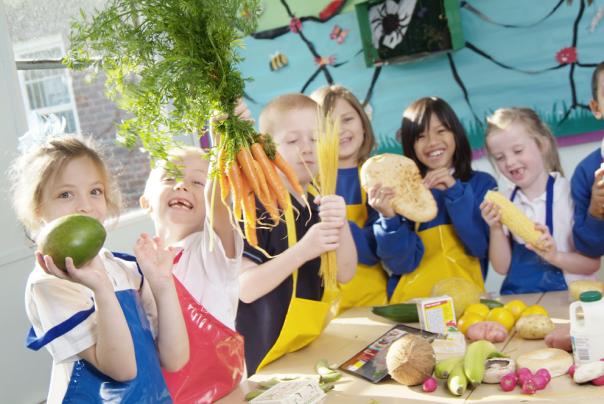
While cooked school meals are one option, BNF acknowledges that many parents and children prefer a packed lunch.
To help ensure kids have the right nutrients and energy to see them through the day, BNF suggests:
- Build the base with starchy foods
The main part of a lunchbox should include starchy foods such as rice, pasta, bread, couscous or pitta. Choosing wholegrain varieties will provide more fibre and a wider range of nutrients.
Many children get well below the recommended intake of fibre, which is important for digestive health and to help keep them healthy in later life. Wholegrains also tend to have a lower glycaemic index, meaning they release energy more slowly – perfect for fuelling children for a busy afternoon at school.
- Fruit and veg – just eat more!
Adults and children should be aiming for at least five portions of fruit and veg a day. This ensures our bodies get enough essential vitamins and minerals, which are crucial for healthy development.
Lunchtime is a great opportunity to pack in these all-important nutrients, so one snack option is fruit and vegetable sticks. You should also include as many vegetables as possible into the main dish. Add mushrooms, peas or tomatoes into a pasta dish, or peppers, sweetcorn and shredded carrot into a wrap, and always include some salad in sandwiches.
- Plenty of protein for growing children
Protein is essential for growth, maintenance and repair of the body – something children are experiencing continuously as they grow up. Therefore a source of protein should be eaten at every lunchtime. Include a variety of foods such as: beans, lentils, pulses, fish, eggs and meat. Use these as sandwich fillings, in couscous, or in a pasta or rice salad.
Top Tip: Try and include fish (especially oily types like salmon) once or twice a week – you could try canned salmon or tuna mixed with a pasta or rice salad or as a sandwich filing.
- Dairy delights
As well as being a source of protein, dairy foods contain calcium – essential for healthy bones and teeth. So if you’re not including dairy as part of a main dish (e.g. in a salad or sandwich), add a yogurt or piece of cheese.
But, as with all snacks, be wary of the sugar content – check the labels and look for those that are lower in sugars. Most yogurts will have an amber traffic light for sugars, however, it’s still worth looking at the numbers and going for those that are lowest.
The recommended daily allowance for a child aged four to six is no more than 19g of free sugars per day; for a child aged seven to ten the recommendation is no more than 24g of free sugars.
- A waterfall of drinks
Always pack a drink! Younger children may be more likely to get dehydrated than adults as they have a higher proportion of body water, and are also less heat tolerant.
Therefore, encouraging children to drink fluids regularly is important. Water and milk should be lunchbox staples and you could also give your child fruit juice or a smoothie, however, due to the high sugar content, these should be limited to a combined total of 150ml a day and can be diluted with water to make them go further.